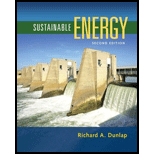
Sustainable Energy
2nd Edition
ISBN: 9781337551663
Author: DUNLAP, Richard A.
Publisher: Cengage,
expand_more
expand_more
format_list_bulleted
Concept explainers
Question
Chapter 1, Problem 18P
To determine
Find the annual heating cost of the second homeowner.
Expert Solution & Answer
Trending nowThis is a popular solution!

Students have asked these similar questions
Replacing incandescent lights with energy-efficient fluorescent lights can reduce the lighting energy consumption to one-fourth of what it was before. The energy consumed by the lamps is eventually converted to heat, and thus switching to energy-efficient lighting also reduces the cooling load in summer but increases the heating load in winter. Consider a building that is heated by a natural gas furnace with an efficiency of 80 percent and cooled by an air conditioner with a COP of 3.5. If electricity costs $0.12/kWh and natural gas costs $1.40/therm (1 therm = 105,500 kJ), determine if efficient lighting will increase or decrease the total energy cost of the building (a) in summer and (b) in winter.
An air-conditioning unit has a cooling capacity of two tons. If the unit has a rated energy efficiency ratio (EER) of 11, how much electrical energy is consumed by the unit in 1 h? If a power company charges 14 cents per kWh usage, how much would it cost to run the air-conditioning unit for a month (31 days), assuming the unit runs 8 h a day? What is the coefficient of performance (COP) for the given air-conditioning unit?
Consider a 400-MW, 32 percent efficient coal-fired power plant that uses cooling water withdrawn from a nearby river (with an upstream flow of 10-m3/s and temperature 20 °C) to take care of waste heat. The heat content of the coal is 8,000 Btu/lb, the carbon content is 60% by mass, and the sulfur content is 2% by mass.
How much electricity (in kWh/yr) would the plant produce each year?
How many pounds per hour of coal would need to be burned at the plant?
Estimate the annual carbon emissions from the plant (in metric tons C/year).
If the cooling water is only allowed to rise in temperature by 10 °C, what flow rate (in m3/s) from the stream would be required?
What would be the river temperature if all the waste heat was transferred to the river water assuming no heat losses during transfer?
Estimate the hourly SO2 emissions (in kg/h) from the plant assuming that all the sulfur is oxidized to SO2 during combustion.
Chapter 1 Solutions
Sustainable Energy
Knowledge Booster
Learn more about
Need a deep-dive on the concept behind this application? Look no further. Learn more about this topic, civil-engineering and related others by exploring similar questions and additional content below.Recommended textbooks for you

 Engineering Fundamentals: An Introduction to Engi...Civil EngineeringISBN:9781305084766Author:Saeed MoaveniPublisher:Cengage Learning
Engineering Fundamentals: An Introduction to Engi...Civil EngineeringISBN:9781305084766Author:Saeed MoaveniPublisher:Cengage Learning


Engineering Fundamentals: An Introduction to Engi...
Civil Engineering
ISBN:9781305084766
Author:Saeed Moaveni
Publisher:Cengage Learning